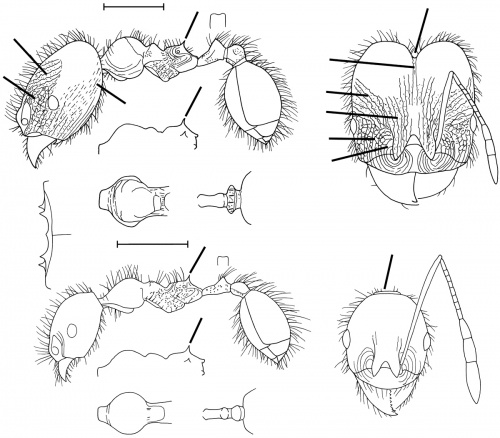Pheidole huacana
| Pheidole huacana | |
|---|---|
| Scientific classification | |
| Kingdom: | Animalia |
| Phylum: | Arthropoda |
| Class: | Insecta |
| Order: | Hymenoptera |
| Family: | Formicidae |
| Subfamily: | Myrmicinae |
| Tribe: | Attini |
| Genus: | Pheidole |
| Species: | P. huacana |
| Binomial name | |
| Pheidole huacana Wilson, 2003 | |
Nothing is known about the biology of huacana.
Identification
See the description in the nomenclature section.
Keys including this Species
Distribution
Only known from the type locality.
Latitudinal Distribution Pattern
Latitudinal Range: -0.6364° to -13.230367°.
| North Temperate |
North Subtropical |
Tropical | South Subtropical |
South Temperate |
- Source: AntMaps
Distribution based on Regional Taxon Lists
Neotropical Region: Ecuador, Peru (type locality).
Distribution based on AntMaps
Distribution based on AntWeb specimens
Check data from AntWeb
Countries Occupied
| Number of countries occupied by this species based on AntWiki Regional Taxon Lists. In general, fewer countries occupied indicates a narrower range, while more countries indicates a more widespread species. |

|
Estimated Abundance
| Relative abundance based on number of AntMaps records per species (this species within the purple bar). Fewer records (to the left) indicates a less abundant/encountered species while more records (to the right) indicates more abundant/encountered species. |

|
Biology
Castes
Nomenclature
The following information is derived from Barry Bolton's Online Catalogue of the Ants of the World.
- huacana. Pheidole huacana Wilson, 2003: 300, figs. (s.w.) PERU.
Unless otherwise noted the text for the remainder of this section is reported from the publication that includes the original description.
Description
A member of the fallax group, close to Pheidole galba and Pheidole oliveirai, distinguished as follows.
Major: yellow; nadir of occipital mid-cleft seen in full-face view very deep, reached by carinulae that start on the vertex and run along the mid line of the head; rugoreticulum on each side of head runs from the eye to and into the circular carinulae around the antennal fossa; the rugoreticulum leads at the level of the posterior margin of the eye to weak rugulae that proceed obliquely toward the lateral head margin; frontal lobes mostly covered by rugulae; propodeal spines well-developed, often nearly vertical as shown; postpetiolar node from above transversely carinulate.
Minor: propodeal spines well-developed; occiput narrowed, with nuchal crest. Propodeal spines directed strongly upwards.
MEASUREMENTS (mm) Holotype major: HW 1.88, HL 2.08, SL 1.10, EL 0.24, PW 0.92. Paratype minor: HW 0.76, HL 0.94, SL 1.18, EL 0.18, PW 0.54.
COLOR Major: concolorous reddish yellow (“orange”).
Minor: concolorous medium yellow.
Figure. Upper: holotype, major. Lower: paratype, minor. Scale bars = 1 mm.
Type Material
PERU: Quincemil, Cuzco, 750 m, col. L. Pena. Museum of Comparative Zoology
Etymology
L huacana, from huaca, belonging to Inca spirits of the land.
References
- Wilson, E. O. 2003. Pheidole in the New World: A dominant, hyperdiverse ant genus. Harvard University Press, Cambridge, MA. (page 300, fig. major, minor described)
References based on Global Ant Biodiversity Informatics
- Bezdeckova K., P. Bedecka, and I. Machar. 2015. A checklist of the ants (Hymenoptera: Formicidae) of Peru. Zootaxa 4020 (1): 101–133.
